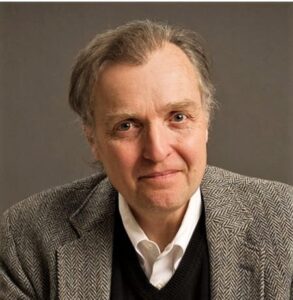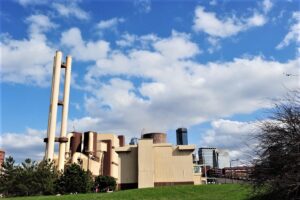BY CAM GORDON

Cam Gordon
County’s new Zero Waste Plan could end garbage burning downtown
Once again, people are organizing to shut down Hennepin County’s downtown garbage burner. The burner, known as the Hennepin Energy Recovery Center (HERC), has been fraught with controversy since before it opened in 1989.
“Communities have been fighting this facility since before it was built,” said Nazir Khan, co-founder of the Minnesota Environmental Justice Table (MEJT), which is a leader in the effort this time around.
The last push for closure was launched in 2016 by a coalition that included the Sierra Club, Neighborhoods Organizing for Change and the Minnesota Public Interest Research Group, which was unsuccessful.
This time could be different.
That is what the people who attended the Feb. 5 meeting at Zion Baptist Church in north Minneapolis hope. There, speakers highlighted the factors that could make a shutdown possible by 2025, including reports confirming harmful air pollution, the deteriorating facility, a change in state law, and the new Hennepin County Zero Waste Plan that is set to be approved in April.
HERC is located on the north edge of downtown and burns an estimated 1,000 tons of garbage every day that is trucked in from all over Hennepin county. The county website says, “HERC uses the latest technologies to reduce environmental and taxpayer costs and is part of the county’s integrated waste management system.” The facility provides electricity to Xcel and steam for heating and cooling to nearby buildings and Target Field, and has been getting renewable energy credits (RECs), which could be sold or held for financial gain, for years. That will end this year.
“HERC will no longer be considered a form of renewable energy,” said state Rep. Frank Hornstein (District 61A), “thanks to the new clean energy law.” Hornstein, who has been a longtime opponent of the burner, called its closure an environmental justice issue that is also contributing to the climate crisis. “The HERC emits more greenhouse gases than a coal-based power plant,” he said. “It is one of the top emitters of global warming emissions in our state.”
 According to a report issued in November 2022 by PSE Healthy Energy, a nonprofit that researches health and energy, “this trash incineration emits health-damaging air pollutants in the middle of a dense, urban community, predominantly made up of low-income households of color.” They found that from 2018 to 2020, HERC burned an average of 342,722 tons a year. Examining the Minnesota Pollution Control Agency data, they found that in 2019 the facility emitted 173,254 tons of carbon dioxide, 12.1 pounds of lead, 404 tons of nitrogen oxides (more than any other source in the county), and 12 tons of sulfur dioxide (second highest in the county).
According to a report issued in November 2022 by PSE Healthy Energy, a nonprofit that researches health and energy, “this trash incineration emits health-damaging air pollutants in the middle of a dense, urban community, predominantly made up of low-income households of color.” They found that from 2018 to 2020, HERC burned an average of 342,722 tons a year. Examining the Minnesota Pollution Control Agency data, they found that in 2019 the facility emitted 173,254 tons of carbon dioxide, 12.1 pounds of lead, 404 tons of nitrogen oxides (more than any other source in the county), and 12 tons of sulfur dioxide (second highest in the county).
The zip codes just north (55411) and just east (55415) of HERC have the second and third highest rates of asthma in the Minneapolis metropolitan area according to the data PSE found.
Audua Pugh, chair of the Jordan neighborhood’s community council, spoke at a meeting about the health impacts on youth. “Kids live next to it, within a half mile, and go to school near it at Harvest Academy,” she said. “The school nurse there says that 50% of the kids there have asthma.”
The county website doesn’t deny that there is air pollution coming from the burner, but says that they use “state-of-the-art air emission control technology” and that “air emissions at HERC are cleaned and treated before being released.”
They admit, for example, that in 2020 HERC emitted 382.5 tons of nitrogen oxides but point out that that is only 47% of the maximum emissions allowed by state regulators.
“One of the main reasons I got involved,” said Khan, “was because of a whistleblower who shared how sorry the state of the facility was.” Through discussions with at least one employee and formal data requests, Khan says that he has learned of many malfunctions in machinery, frequent shutdowns needed to make repairs, broken filters, holes in the smokestacks, and worker injuries, including one in 2017 when one worker was hospitalized for six months.
Khan believes that the increasing amount of money needed to keep this aging incinerator operational could instead be spent on waste diversion efforts. He and the MEJT want the county to shut down the HERC trash burner and instead invest personnel, money and other resources toward handling waste more effectively.
That looks more possible now because the county is developing a Zero Waste Plan that the group hopes will include a waste management future that no longer depends on burning garbage. In the drafting of that plan it appears that it is already committing to a future where it diverts “90% or more of all discarded materials from landfills and incinerators.”
Northside state Rep. Esther Agbaje (District 59B) was also at the meeting and supports closing HERC. She said that she is working on a zero-waste bill at the state level and looking for ways to expand composting and organics collection at multi-unit buildings.
Retiring HERC would require finding alternative ways to manage the waste currently being burned there. According to the county, the waste it receives by weight is 16% paper, 2% glass, 5% metals, 15% plastic, 32% organics, and 30% other. The paper, glass, metals, and some of the plastic could be recycled and the organics could be composted. That would leave 30% to be reduced, reused or landfilled. An estimated 23% of the tonnage currently goes to landfills in the form of ash.
Khan, Pugh and other advocates are calling on the county to set a closing date of December 2025 for HERC in their approved Zero Waste Plan. That is also the date that its current contract with Great River Energy to operate the facility ends.
The draft Zero Waste Plan that was released for public review on Feb. 22 falls short of setting a date, but does call for the county to “establish milestones to phase out the use of HERC as the county approaches zero waste.”
“We clearly have some support on the commission,” says Pugh, pointing to Commissioners Angela Conley and Irene Fernando as being the most supportive, and most likely to help amend the plan to include the date.
Conley was able to get approval of the provision to phase out HERC in the county’s climate action plan and has been reviewing the latest draft of the Zero Waste Plan.
“I can’t stand firm on a closure date without a couple things being true first,” Conley said. She wants to know that the HERC funds the county now depends on for its environmental programs will be replaced and that the waste will be reduced and not just buried or burned somewhere else. “I can absolutely see a future without HERC,” she stressed.
Khan said that he believes getting a date set for closure will help motivate the county, and the community, to accomplish the 90% diversion called for in the plan. “We have to create external pressure,” he said.
On March 5, MEJT, MFT 59 (the Minneapolis Federation of Teachers), Teamsters Local 320 and SEIU Local 26 held a rally to educate people and build momentum for the effort.
“We are not only going to shut down the facility,” said Hornstein. “We are going to make this a zero-waste county.”
























